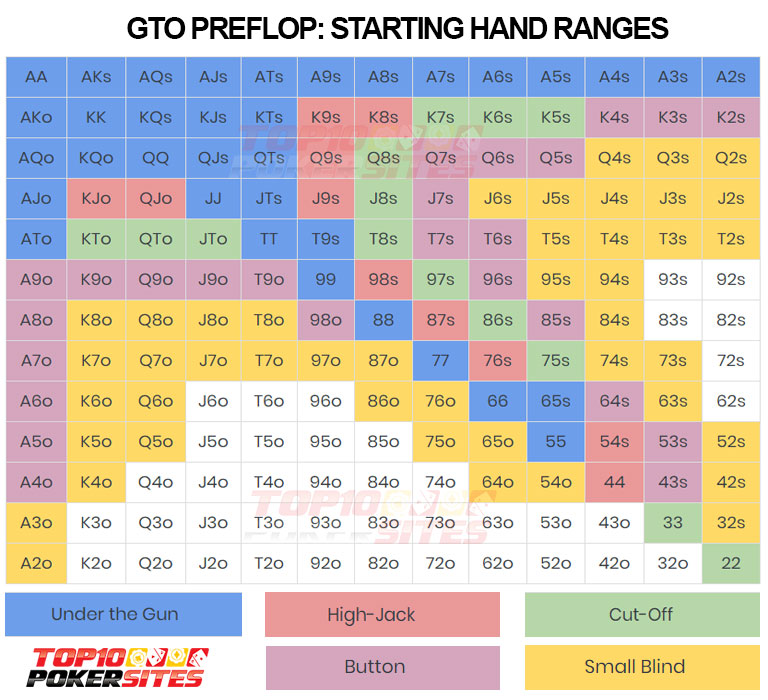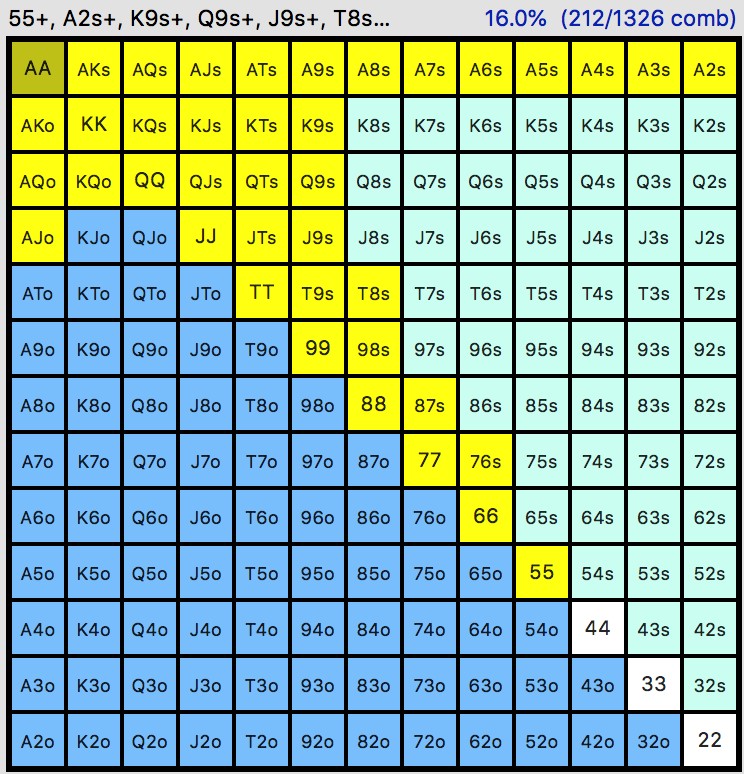Poker Hands Preflop
- Poker Preflop Hand Chart
- Worst Poker Hands Preflop
- Poker Hand Preflop Calculator
- Best Preflop Poker Hands
- Top Poker Hands Preflop
- Poker Hands Preflop
The Free Preflop Advisor is available as a mobile download and web compatible app. The free app provides advice on how to play hole cards in a variety of situations for 6-max NL Hold'em tables. Follow the instructions below to get started and optimize your. Preflop is the most common and important street in poker. The decisions you make on this street will greatly impact the rest of the hand. The hands are organized by position or the order in which you act at the table. Play starts out with the Under The Gun (UTG) player, then moves to UTG+1, UTG+2, LoJack (LJ), HiJack (HJ), Cutoff (CO), Button (BTN). PLO 20bb, 30bb, 50bb, and 100bb With the tens of thousands of possible PLO hands, the best method to mastering preflop PLO is in developing your hand evaluation skills through practice. PLO ranges are all solver-based with micro-stakes, mid-stakes, and high-stakes. How to play your hands preflop: You must consider your position in how you play your hand in Texas hold'em. You must know what kind of action you want with your hand, and play accordingly from your position. You obviously must play only very good hands from early position, because you have very little control over how the hand will develop.
Knowing what hands to play preflop is key to your poker success! The hands you play preflop are the starting point of your game. A poor preflop strategy is like building a house on quicksand – you will go nowhere quickly. There is a very good reason engineers dig a deep hole when building skyscrapers – you need a solid foundation.
Hand Guide: Preflop > Flop > Turn > River
Preflop Planning is an excellent guide on how to think before the flop when deciding whether to fold, call or raise based on your position and starting hand. It's the perfect compliment to this article.
Preflop overview.
Before the flop is where it all starts, where you are forced to make your first important decision depending on all of the variables involved with the hand. It is important to make good, solid decisions before the flop, as it will form the foundations for how the rest of the hand will be played out.
If you make a high-quality decision before the flop, you will set the tone for the rest of the hand and give yourself the best opportunity to get into a moneymaking position. However, if you make a bad decision before the flop, you may well set yourself up for a big loss by getting yourself into a sticky position or missing out on a potentially rewarding hand.
Start as you mean to go on in every hand. Make quality plays at the beginning and continue throughout the rest of the hand.
Therefore after you have been dealt your cards preflop, it is important to take your time to evaluate all of the different variables in the hand, and not just make decisions on the cards that you are holding. It is important to consider your position and the type of opponents you are playing against, as well as know the correct starting hand requirements. So make sure you think very carefully before every flop and build the foundations for a profitable hand by making the correct preflop strategy decision.
Preflop starting hand selection.
Choosing which hands to play and which hands to fold is fundamental to playing a winning poker game. The best hands to play in Texas Holdem are:
- Big pocket pairs: AA-TT
- Big suited connectors: AK, AQ, AJ, KQ
- Big connectors: AK, AQ, AJ, KQ
These particular combinations of cards have the best chances of winning than other cards, so if you stick to these you will find yourself in more profitable situations after the flop. It is possible to play other combinations of cards successfully, but if you are a beginner player then it is advised to stick with the big cards until you find your feet at the poker table.
Preflop position strategy.
Your position in the hand is an incredibly important variable that you should be aware of in every hand, yet it is something that is all too often forgotten about.
The dynamics of play are slightly different in the preflop betting round, as the small and big blind will be last to act, whereas they will be the first to act on every other betting round. However, the general principles of position will remain the same, as you want to try and play more hands where you have position over your opponents than in positions where you do not.
This means that you should avoid playing too many hands in the blinds or in an early position, as being one of the first to act in each hand can make things very difficult unless you are holding a premium hand. Be very careful when playing in the blinds, and don’t feel as though you have to enter more pots in these positions because you have already committed money to the pot. It is far safer to let marginal hands go rather than to call raises with half a holding and play out of position for the rest of the hand.
Your position can often play a more influential role than the strength of the cards that players are actually holding, so try and keeping the upper hand by combining good position with good cards.
The cards listed above in the starting hands selection section can be played from almost any position, but you should try and tighten up your starting hand selection in the earlier positions. So as a general rule, you can play with a wider range of the top starting hands in later positions than you should in the earlier positions in the hand.
So the top strategy tips on preflop position are:
- Always be aware of your position in a hand
- Try to avoid playing out of position unless you have a strong holding
- You can afford to loosen up your starting hand requirements in later positions
- Don’t feel committed to playing hands when in the blinds
Preflop betting tips.
When the action reaches you before the flop, you will be faced with the decision to either fold, call or raise. If there has been no raise before you, then a call will simply mean matching the size of the big blind, which is also known as ‘limping in’. This is generally not a good play, as if you are entering any pot in Holdem you will want to be making a raise and show aggression.
If you are limping in with a hand, you are either entering the pot with a sub-standard hand or you are playing a premium hand too weakly. So the real question you should ask yourself if you are first to enter the pot before the flop is; “Am I folding or am I raising?”
The majority of the time you should either 'pump it' or 'dump it'. Avoid limping in by simply calling the big blind.
Preflop bet sizing.
If you decide that you are going to enter the pot, you should be looking to make a raise of about 3 or 4 times the size of the big blind. By making a minimum raise you are letting opponents with marginal hands come in cheaply, and you are almost defeating the object of making a preflop raise.
The idea of a preflop raise is to reduce the amount of players who follow you to see a flop, as it is easier to make profitable decisions when there are fewer players in the pot. So make sure to come in with a strong 3 or 4 BB raise, and increase the size of the raise if you find that a lot of players are still calling these raises with marginal hands or if other players have limped in before you.
If there has been a raise before you, you must now consider whether you should fold, call or raise. If you have a poor or marginal starting hand you should look to fold. If you have a good starting hand like the ones mentioned above you should be happy to call and see a flop. If you have one of the top starting hands like AA or KK, should re-raise to help try and get as much money into the pot as possible.
Limping in.
There will be a few cases where limping-in will be an acceptable play. This will normally be when there have been a number of other players limping-in before you, and so you will have better odds to see a flop.
The best hands to limp in with are strong drawing hands such as suited cards with an ace or king, or any connecting cards that can make a straight. You are not looking to make top pair in these limped multi-way pots, as they can often land you in trouble. So aim to play hands that can land you a very strong holding or a strong draw, and then comfortably fold on the flop if neither of these materialize.
Top strategy tips for preflop betting:
- Don’t be afraid to bet or raise
- Make solid 3 or 4 BB raises when entering an un-opened pot
- Increase the size of your raise if other players have limped or are calling stations
- Avoid limping with mediocre hands
- Only limp if you have a potentially strong hand and others have limped before you
Other preflop strategy tips.
If you are playing in a shorthanded game such as a 6-max table, you can afford to reduce your starting hand requirements so that you can see more flops. If you stick to the starting hand requirements mentioned above, you would probably find that you are folding too often and missing out on opportunities to win money. So you can afford to play other hands such as AT, KJ, KT, QJ and so on.
When making your decision pre flop, you should also consider the type of players who you are playing against. If you notice that a tight player has made a raise, it is likely that they have a very strong hand, so you should re-evaluate the strength of your cards in this hand. Similarly, if a loose player makes a raise, it is more likely to be profitable to be call with a decent hand as you could well be holding a stronger hand than them.

It is important to not be afraid about making bets or raises before the flop. It is important to be aggressive in poker, as it is a winning style that all good players adopt. If you are afraid to make bets and raises when you should be, then you will be making unprofitable decisions and you will find it hard to ever win money from the game. To help accustom yourself to being aggressive, you could try dropping down in limits where there is less money at stake, so that you can become comfortable with playing aggressively and notice the advantages of an aggressive style over a weak playing style.
Useful preflop strategy articles:
- Starting Hand Selection (Beginner)
- Position (Beginner)
- The Gap Concept (Intermediate)
- Relative Position (Advanced)
Go back to the thorough hand guide.
- vs Open
- Squeeze
- vs 3bet
- vs 4bet
These preflop ranges have been specifically designed for 100BB deep games with medium rake.
Each preflop matrix will have a raise size associated with it which must be used for the range to be balanced.
New Color Key
Purple = 100% Raise
Red = 75% Raise, 25% Call
Orange = 50% Raise, 50% Call
Yellow = 25% Raise, 75% Call

Green = 100% Call
Pink = 25% Raise, 75% Fold
Dark Blue = 50% Raise, 50% Fold
White = 50% Call, 50% Fold
Light Blue = 25% Raise, 25% Call, 50% Fold
Poker Preflop Hand Chart
Grey = 100% Fold
Old Color Key
Red = Always Raise
Orange = Often Raise, otherwise Call
Yellow = Sometimes Raise, otherwise Call
Green = Always Call
Pink = Sometimes Raise, otherwise Fold
White = Call or Fold
Blue = Raise, Call or Fold
Worst Poker Hands Preflop
Grey = Always Fold
Seat Names
Big Blind (BB): The player in the big blind
Small Blind (SB): The player in the small blind
Poker Hand Preflop Calculator


Best Preflop Poker Hands
Button (BU): The player on the button
Cutoff (CO): The player to the immediate right of the button
Top Poker Hands Preflop
Hijack (HJ): The player two seats to the right of the button
Lojack (LJ): The player three seats to the right of the button. First to act in 6-max
Under-The-Gun +2 (UTG2): The player four seats to the right of the button
Under-The-Gun +1 (UTG1): The player five seats to the right of the button
Under-The-Gun (UTG): The player six seats to the right of the button. First to act in Full Ring
Poker Hands Preflop
Early Position (EP): Either UTG, UTG1 or UTG2
Middle Position (MP): Either LJ or HJ
Late Position (LP): Either CO or BTN